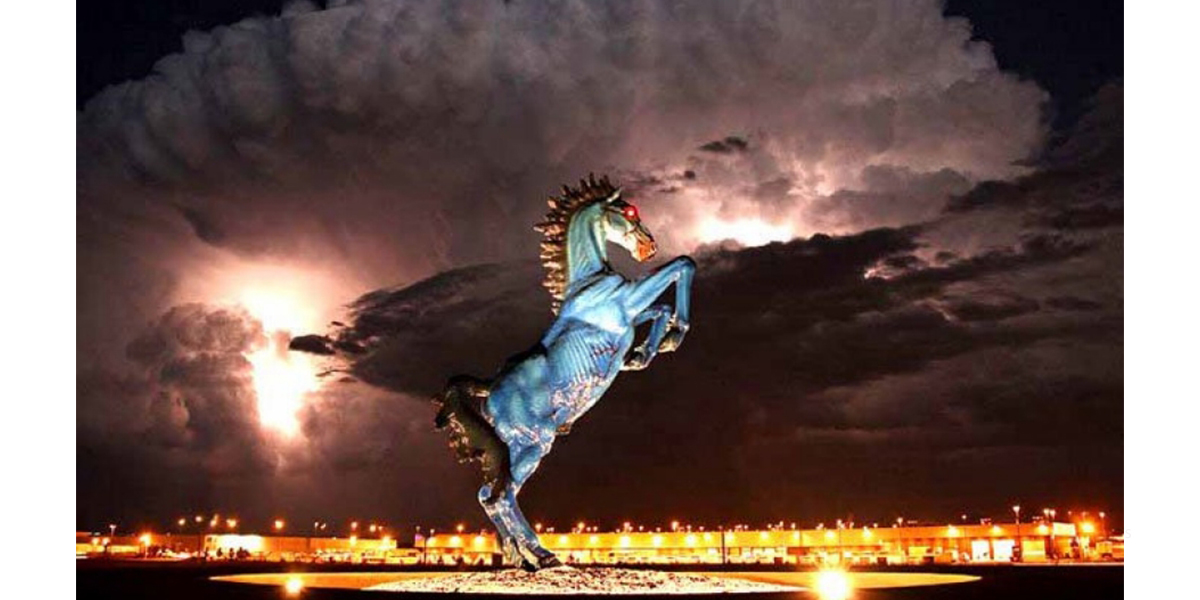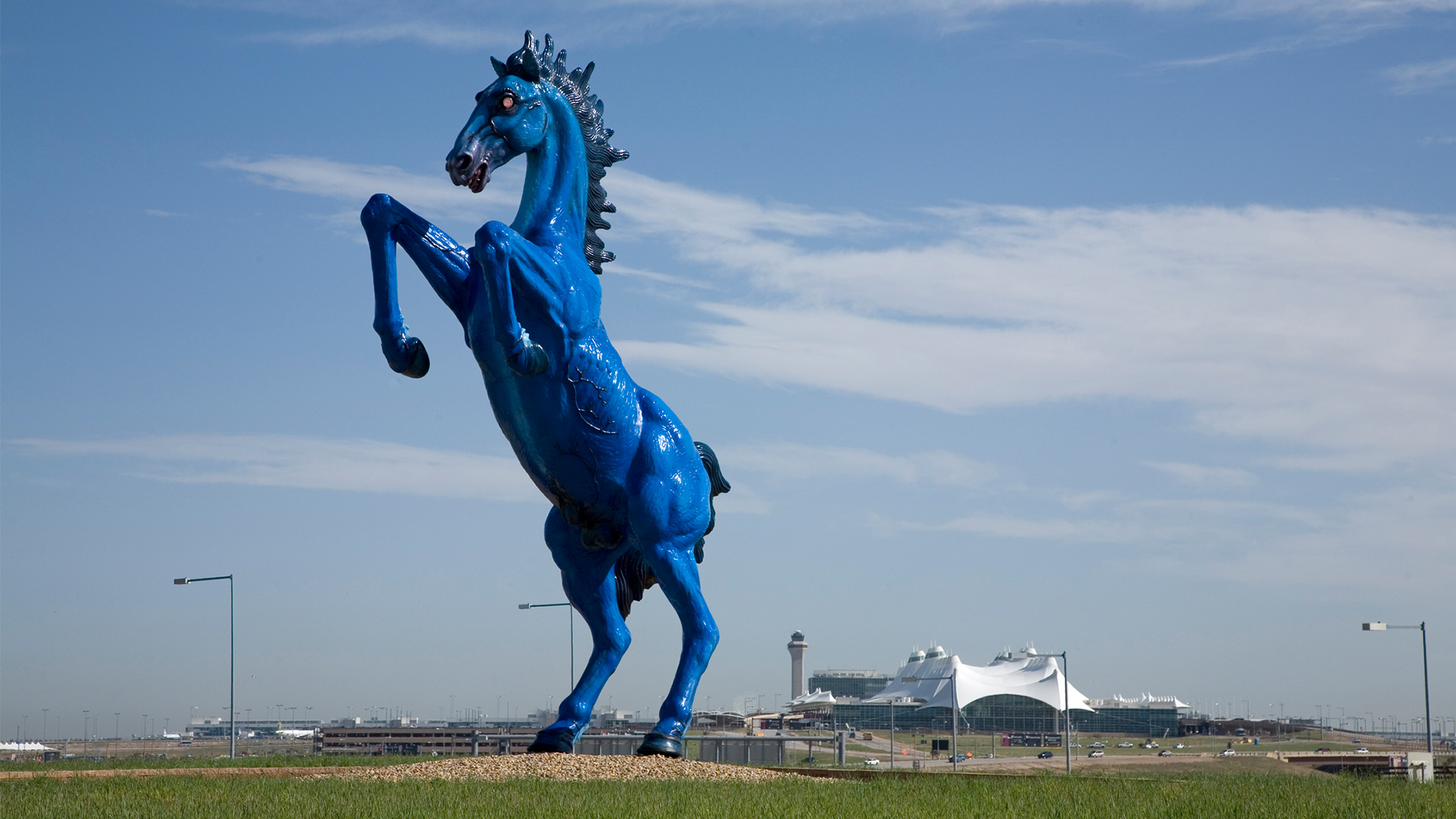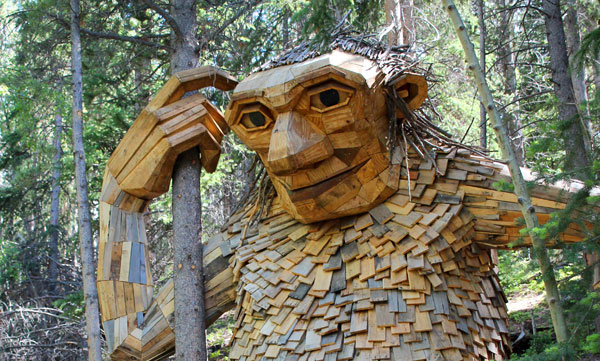DIA Rearing Blue Mustang – Blucifer
The Story Behind Blucifer, the Big Blue Mustang
When heading in or out of Denver International Airport (DIA), it’s hard to miss Blucifer, the big blue sculpture of a stallion horse, rearing up on its hind legs, looking defiantly towards the mountains. If it’s after sunset, you’ll probably notice its fiery red eyes blazing. It’s loved by many, and also hated by some vocal opponents for various reasons. The title of the sculpture is Mustang/ Mesteno(Spanish). Simple, one-word, evoking images of the American West, or perhaps wild horses in the U.S., the iconic vehicle of the nineteen sixties, or whatever the word means to you. I live in Colorado and am on a horse ranch, so I admit to a personal bias in favor of this giant blue equine homage to the spirit of freedom, the West, and our nation. But before I discuss my views, it’s appropriate that I detail the history of how and why Blucifer(as many locals call it) is there in the first place.Blucifer and Artist, Luis Alfonso Jimenez Jr.
To understand the sculpture as the artist intended it. It is necessary to delve into who the artist was, and why his art was, and why he remains timelessly important. Luis Alfonso Jimenez Jr was born in El Paso, Texas, on July 30, 1940. Luis Sr, his father, ran a sign shop in the Segundo neighborhood, a primarily Mexican American area of El Paso. He had aspired to become an artist, though it never really happened in the way he wanted. He produced vibrant, neon, and fiberglass signs for local businesses, and the young Luis began working off and on in the shop at age six. Seeing his father’s work and being artistically inclined, he knew he wanted to pursue art. Working at the shop made him familiar with the materials used: fiberglass, paint, and metal.
Mexican Heritage
On family trips to Mexico, the young Luis absorbed his ancestral ancestors' colors, textures, sights, and sounds. He noticed the Spanish influences were mixed with the native cultures and that Mexicans were the modern-day representatives of these two peoples whose cultures had merged into the Mexican people. Growing up, he also noticed that his people were second-class citizens within the framework of Anglo-American society. He understood early on that he would need to leave El Paso if he wanted to pursue a career in the art world. He left in 1960 to attend the University of Texas at Austin. He would later comment that his experience there led him to meet many people from many different places and that exposure progressed him as an artist.
Life as an Artist
After receiving his fine arts degree in 1964, he visited Mexico City to explore, interact, and meet new people. Two years later, he moved to New York City, worked on his art projects, and produced several sculptures. He went to various galleries and showed people photos of his work, but no one seemed interested. However, New York was a big town with hundreds of art galleries. He finally decided to haul in several large sculptures to a prestigious gallery. At first outraged, the gallery director later became fascinated with the work and directed Luis to the Graham Gallery, which soon launched a solo show. Appealing immediately to art collectors, the gallery hosted a second show, and Luis became increasingly well-known in the NYC art scene.
Mexican American Expressionist
By this time, his work displayed the clash between his culture and the dominant themes prominent in the US. These themes are present today, and nothing about Jimenez’s work is outdated. Working in fiberglass, paint, and metal allowed him to express his love of shapes and colors and was closely connected to his Mexican American roots and blue-collar origins. The brilliant colors found in Aztec and Mayan artworks from hundreds of years ago are all part of Jimenez’s palette and are part of Mexican American and Chicano culture today.

Works Became Popular
His work became known for its bold use of colors and shapes and for its topics that frequently were about the Mexican American experience in the United States. From topics of rodeo riders, cowboys, and steel workers to religion and LowRiders, his work became well-known in the art world. He made several sculptures for cities throughout the southwest that were on public display. He became famous and admired throughout the 1980s. He was even invited to dinner at the White House by President George W. Bush, an admirer of his work. His style and subject matter were frequently controversial, but isn’t that part of what art is supposed to do? We perceive reality differently, and it would be a boring world if we all liked the same thing every time, with no exceptions. So if the big blue horse, Blucifer, is a little unsettling to you, relax; it’s meant to be! This renown prompted the city of Denver, in 1992, to contract with Jimenez to create a giant sculpture for its newly proposed airport.
The Rearing Blue Stallion Installation
Work progressed slowly, but the final version of Mustang was a 32-foot-high rearing stallion made of blue fiberglass with two red, large, led-lit eyes. Here’s where the story turns dark.
Blucifer Created
Though commissioned in 1992, the Mustang sculpture was the subject of much legal wrangling, and it wasn’t until 2006 that Jiminez completed it. While hoisting the large piece, part of it swung around and pinned Jimenez between it and a steel beam, severing a major artery. An ambulance was called, but Luis Jimenez died from blood loss en route to the hospital.
His studio staff, family, and friends helped finish the sculpture, but his untimely death also started lots of chatter about his being killed by Blucifer. It’s a perfect internet subject that has been rehashed time after time, even leading some to theorize it’s part of a vast “alien conspiracy” that also believes DIA is a secret CIA/FBI/UFO base with underground tunnels, portals to other dimensions, or you can fill in the blanks if you have your theory.
Whatever you believe, or no matter what you think of the giant blue stallion, whether it offends you or if you see some deeper meaning in it, you’ll undoubtedly remember Blucifer and associate it with the city of Denver.






